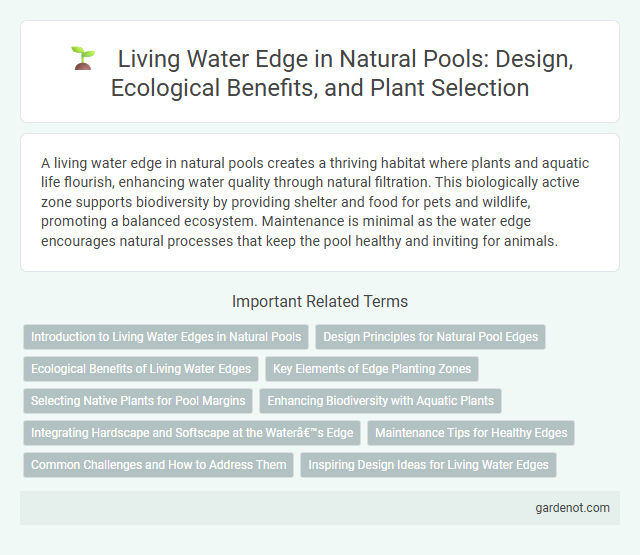A living water edge in natural pools creates a thriving habitat where plants and aquatic life flourish, enhancing water quality through natural filtration. This biologically active zone supports biodiversity by providing shelter and food for pets and wildlife, promoting a balanced ecosystem. Maintenance is minimal as the water edge encourages natural processes that keep the pool healthy and inviting for animals.
Introduction to Living Water Edges in Natural Pools
Living water edges in natural pools replicate the transitional zone between aquatic and terrestrial ecosystems, enhancing biodiversity and water quality. This ecotone supports diverse plant species that naturally filter pollutants and provide habitat for microorganisms critical to the pool's self-sustaining ecosystem. Incorporating living water edges promotes balanced nutrient cycles, reduces algae growth, and fosters a resilient, chemical-free swimming environment.
Design Principles for Natural Pool Edges
Living water edges in natural pools utilize biofiltration zones with aquatic plants to enhance water purification and create seamless transitions between water and landscape. Design principles emphasize gentle slopes, diverse plant species selection, and substrate layering to maximize habitat diversity and prevent erosion. Integrating natural materials and fostering ecological balance supports sustainable, visually appealing water edges that promote healthy aquatic ecosystems.
Ecological Benefits of Living Water Edges
Living water edges enhance biodiversity by providing habitat for aquatic plants, insects, and amphibians, which contributes to a balanced ecosystem. These natural buffers improve water quality through filtration, trapping sediments, and reducing nutrient run-off, which mitigates algae growth and promotes clearer, healthier water. By stabilizing shorelines and supporting native vegetation, living water edges combat erosion and foster resilience against environmental fluctuations in natural pool settings.
Key Elements of Edge Planting Zones
Living water edges in natural pools feature key planting zones designed to enhance filtration, provide habitat, and maintain water clarity. Emergent plants dominate the shallow marginal zone, stabilizing substrate and filtering nutrients, while submerged plants oxygenate the water and support aquatic life. The transition from marginal to deeper zones incorporates moisture-tolerant species that form a seamless interface between water and landscape, promoting biodiversity and ecological balance.
Selecting Native Plants for Pool Margins
Selecting native plants for the living water edge of a natural pool enhances ecological balance and water quality by supporting local wildlife and reducing maintenance needs. Optimal choices include water-loving species like cattails, sedges, and pickerelweed, which stabilize the pool margins and filter pollutants naturally. These native plants promote biodiversity, prevent erosion, and create a seamless transition between the aquatic environment and surrounding landscape.
Enhancing Biodiversity with Aquatic Plants
Enhancing biodiversity in a living water edge is achieved by strategically incorporating diverse aquatic plants such as water lilies, cattails, and submerged oxygenators. These plants not only provide natural filtration, improve water quality, and stabilize the shoreline but also create habitats for fish, amphibians, and beneficial insects. Integrating native species promotes ecological balance while supporting a thriving, self-sustaining natural pool ecosystem.
Integrating Hardscape and Softscape at the Water’s Edge
Living water edges in natural pools seamlessly blend hardscape elements like stone or wood decking with softscape features such as aquatic plants and grasses, creating a harmonious transition between water and land. This integration enhances ecosystem health by promoting biodiversity and natural filtration while providing an aesthetically pleasing, functional barrier that stabilizes the shoreline. Strategic placement of rocks and native vegetation fosters habitat for local wildlife and supports water quality through biofiltration processes.
Maintenance Tips for Healthy Edges
Maintaining a living water edge in a natural pool requires regular removal of debris and careful monitoring of plant health to ensure optimal filtration and water quality. Use gentle pruning techniques to prevent overgrowth while preserving the ecological balance of native aquatic plants that stabilize the shoreline. Regularly check for erosion and reinforce banks with natural materials like stones or biodegradable fabric to support healthy, sustainable edges.
Common Challenges and How to Address Them
Algae overgrowth is a common challenge in living water edges, caused by nutrient imbalances and insufficient circulation. Implementing a balance of aquatic plants and regular water movement helps control algae naturally. Maintaining proper filtration and avoiding excess organic debris also supports a healthy, clear water edge ecosystem.
Inspiring Design Ideas for Living Water Edges
Living water edges enhance natural pools by seamlessly integrating aquatic plants and stone materials to create a harmonious transition between water and land. Incorporating native wetland vegetation not only improves water quality but adds dynamic textures and colors to the design. Utilizing curved contours and varied depths encourages wildlife habitation while providing visual interest and a tranquil, eco-friendly ambiance.
Living water edge Infographic

 gardenot.com
gardenot.com